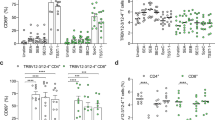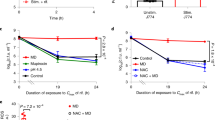Abstract
Staphylococcal superantigens are pyrogenic exotoxins that cause massive T cell activation leading to toxic shock syndrome and death. Despite the strong adaptive immune response induced by these toxins, infections by superantigen-producing staphylococci are very common clinical events. We hypothesized that this may be partly a result of staphylococcal strains having developed strategies that downregulate the T cell response to these toxins. Here we show that the human interleukin-2 response to staphylococcal superantigens is inhibited by the simultaneous presence of bacteria. Such a downregulatory effect is the result of peptidoglycan-embedded molecules binding to Toll-like receptor 2 and inducing interleukin-10 production and apoptosis of antigen-presenting cells. We corroborated these findings in vivo by showing substantial prevention of mortality after simultaneous administration of staphylococcal enterotoxin B with either heat-killed staphylococci or Staphylococcus aureus peptidoglycan in mouse models of superantigen-induced toxic shock syndrome.
This is a preview of subscription content, access via your institution
Access options
Subscribe to this journal
Receive 12 print issues and online access
$209.00 per year
only $17.42 per issue
Buy this article
- Purchase on Springer Link
- Instant access to full article PDF
Prices may be subject to local taxes which are calculated during checkout






Similar content being viewed by others
References
Chambers, H.F. The changing epidemiology of Staphylococcus aureus? Emerg. Infect. Dis. 7, 178–182 (2001).
Kuehnert, M.J. et al. Methicillin-resistant Staphylococcus aureus hospitalizations, United States. Emerg. Infect. Dis. 11, 868–872 (2005).
Klein, E., Smith, D.L. & Laxminarayan, R. Hospitalizations and deaths caused by methicillin-resistant Staphylococcus aureus, United States, 1999–2005. Emerg. Infect. Dis. 13, 1840–1846 (2007).
Rubin, R.J. et al. The economic impact of Staphylococcus aureus infection in New York City hospitals. Emerg. Infect. Dis. 5, 9–17 (1999).
Proft, T. & Fraser, J.D. Bacterial superantigens. Clin. Exp. Immunol. 133, 299–306 (2003).
Sundberg, E.J., Deng, L. & Mariuzza, R.A. TCR recognition of peptide/MHC class II complexes and superantigens. Semin. Immunol. 19, 262–271 (2007).
Bueno, C., Criado, G., McCormick, J.K. & Madrenas, J. T cell signalling induced by bacterial superantigens. Chem. Immunol. Allergy 93, 161–180 (2007).
Becker, K. et al. Prevalence of genes encoding pyrogenic toxin superantigens and exfoliative toxins among strains of Staphylococcus aureus isolated from blood and nasal specimens. J. Clin. Microbiol. 41, 1434–1439 (2003).
Mempel, M. et al. High prevalence of superantigens associated with the egc locus in Staphylococcus aureus isolates from patients with atopic eczema. Eur. J. Clin. Microbiol. Infect. Dis. 22, 306–309 (2003).
Nashev, D. et al. Distribution of virulence genes of Staphylococcus aureus isolated from stable nasal carriers. FEMS Microbiol. Lett. 233, 45–52 (2004).
Parsonnet, J. et al. Prevalence of toxin shock syndrome toxin 1–producing Staphylococcus aureus and the presence of antibodies to this superantigen in menstruating women. J. Clin. Microbiol. 43, 4628–4634 (2005).
Schmitz, F.J. et al. Enterotoxin and TSS toxin-1 production of methicillin resistant and methicillin sensitive Staphylococcus aureus strains. Eur. J. Epidemiol. 13, 699–708 (1997).
Davis, J.P., Chesney, P.J., Wand, P.J. & LaVenture, M. Toxic-shock syndrome: epidemiologic features, recurrence, risk factors and prevention. N. Engl. J. Med. 303, 1429–1435 (1980).
Centers for Disease Control and Prevention. Historical perspectives—reduced incidence of menstrual toxic-shock syndrome—United States, 1980–1990. MMWR Morb. Mortal. Wkly. Rep. 39, 421–423 (1990).
Holtfreter, S. et al. Staphylococcus aureus carriers neutralize superantigens by antibodies specific for their colonizing strain: a potential explanation for their improved prognosis in severe sepsis. J. Infect. Dis. 193, 1275–1278 (2006).
Schlievert, P.M. et al. α and β chains of hemoglobin inhibit production of Staphylococcus aureus exotoxins. Biochemistry 46, 14349–14358 (2007).
Llewelyn, M. & Cohen, J. Superantigens: microbial agents that corrupt immunity. Lancet Infect. Dis. 2, 156–162 (2002).
Chuang, Y.Y., Huang, Y.C. & Lin, T.Y. TSS in children: epidemiology, pathogenesis and management. Paediatr. Drugs 7, 11–25 (2005).
Adem, P.V. et al. Staphylococcus aureus sepsis and the Waterhouse-Friderichsen syndrome in children. N. Engl. J. Med. 353, 1245–1251 (2005).
McCormick, J.K., Yarwood, J.M. & Schlievert, P.M. TSS and bacterial superantigens: an update. Annu. Rev. Microbiol. 55, 77–104 (2001).
Bueno, C. et al. Bacterial superantigens bypass Lck-dependent T cell receptor signaling by activating a Gα11-dependent, PLC-β–mediated pathway. Immunity 25, 67–78 (2006).
Teft, W.A. & Madrenas, J. Molecular determinants of inverse agonist activity of biologicals targeting CTLA-4. J. Immunol. 179, 3631–3637 (2007).
Willems, F. et al. Interleukin-10 inhibits B7 and intercellular adhesion molecule-1 expression on human monocytes. Eur. J. Immunol. 24, 1007–1009 (1994).
Buelens, C. et al. Interleukin-10 differentially regulates B7-1 (CD80) and B7-2 (CD86) expression on human peripheral blood dendritic cells. Eur. J. Immunol. 25, 2668–2672 (1995).
Jankovic, D. & Trinchieri, G. IL-10 or not IL-10: that is the question. Nat. Immunol. 8, 1281–1283 (2007).
Ito, K. et al. HLA-DR4-IE chimeric class II transgenic, murine class II-deficient mice are susceptible to experimental allergic encephalomyelitis. J. Exp. Med. 183, 2635–2644 (1996).
Stiles, B.G., Campbell, Y.G., Castle, R.M. & Grove, S.A. Correlation of temperature and toxicity in murine studies of staphylococcal enterotoxins and TSS toxin 1. Infect. Immun. 67, 1521–1525 (1999).
Criado, G. & Madrenas, J. Superantigen stimulation reveals the contribution of Lck to negative regulation of T cell activation. J. Immunol. 172, 222–230 (2004).
Becker, C.E. & O'Neill, L.A. Inflammasomes in inflammatory disorders: the role of TLRs and their interactions with NLRs. Semin. Immunopathol. 29, 239–248 (2007).
Hashimoto, M. et al. Not lipoteichoic acid but lipoproteins appear to be the dominant immunobiologically active compounds in Staphylococcus aureus. J. Immunol. 177, 3162–3169 (2006).
Wang, J.E. et al. Peptidoglycan and lipoteichoic acid from Staphylococcus aureus induce tumor necrosis factor α, interleukin 6 (IL-6), and IL-10 production in both T cells and monocytes in a human whole blood model. Infect. Immun. 68, 3965–3970 (2000).
Stuyt, R.J. et al. Differential roles of interleukin-18 (IL-18) and IL-12 for induction of γ interferon by staphylococcal cell wall components and superantigens. Infect. Immun. 69, 5025–5030 (2001).
Nakagawa, Y. & Murai, T. Staphylococcal peptidoglycan suppresses production of interleukin-2 by T cells through a T cell–derived factor induced by direct contact between T cells and monocytes. J. Infect. Dis. 188, 1284–1294 (2003).
Ozinsky, A. et al. The repertoire for pattern recognition of pathogens by the innate immune system is defined by cooperation between Toll-like receptors. Proc. Natl. Acad. Sci. USA 97, 13766–13771 (2000).
Into, T. et al. Stimulation of human Toll-like receptor (TLR) 2 and TLR6 with membrane lipoproteins of Mycoplasma fermentans induces apoptotic cell death after NF-kappa B activation. Cell. Microbiol. 6, 187–199 (2004).
Dillon, S. et al. Yeast zymosan, a stimulus for TLR2 and dectin-1, induces regulatory antigen-presenting cells and immunological tolerance. J. Clin. Invest. 116, 916–928 (2006).
Roy, C.R. & Mocarski, E.S. Pathogen subversion of cell-intrinsic innate immunity. Nat. Immunol. 8, 1179–1187 (2007).
Netea, M.G. et al. Toll-like receptor 2 suppresses immunity against Candida albicans through induction of IL-10 and regulatory T cells. J. Immunol. 172, 3712–3718 (2004).
Guo, H., Wu, X., Yu, F.S. & Zhao, J. Toll-like receptor 2 mediates the induction of IL-10 in corneal fibroblasts in response to Fusarium solu. Immunol. Cell Biol. 86, 271–276 (2008).
Sing, A. et al. Yersinia V-antigen exploits Toll-like receptor 2 and CD14 for interleukin 10–mediated immunosuppression. J. Exp. Med. 196, 1017–1024 (2002).
Kabelitz, D. Expression and function of Toll-like receptors in T lymphocytes. Curr. Opin. Immunol. 19, 39–45 (2007).
Liu, H., Komai-Koma, M., Xu, D. & Liew, F.Y. Toll-like receptor 2 signaling modulates the functions of CD4+ CD25+ regulatory T cells. Proc. Natl. Acad. Sci. USA 103, 7048–7053 (2006).
Sutmuller, R.P. et al. Toll-like receptor 2 controls expansion and function of regulatory T cells. J. Clin. Invest. 116, 485–494 (2006).
Haslinger-Löffler, B. et al. Staphylococcus aureus induces caspase-independent cell death in human peritoneal mesothelial cells. Kidney Int. 70, 1089–1098 (2006).
Aliprantis, A.O., Yang, R.B., Weiss, D.S., Godowski, P. & Zychlinsky, A. The apoptotic signaling pathway activated by Toll-like receptor-2. EMBO J. 19, 3325–3336 (2000).
Navarre, W.W. & Zychlinsky, A. Pathogen-induced apoptosis of macrophages: a common end for different pathogenic strategies. Cell. Microbiol. 2, 265–273 (2000).
Venet, F. et al. Human CD4+CD25+ regulatory T lymphocytes inhibit lipopolysaccharide-induced monocyte survival through a Fas/Fas ligand–dependent mechanism. J. Immunol. 177, 6540–6547 (2006).
Vella, A.T., McCormack, J.E., Linsley, P.S., Kappler, J.W. & Marrack, P. Lipopolysaccharide interferes with the induction of peripheral T cell death. Immunity 2, 261–270 (1995).
Bean, A.G., Freiberg, R.A., Andrade, S., Menon, S. & Zlotnik, A. Interleukin 10 protects mice against staphylococcal enterotoxin B–induced lethal shock. Infect. Immun. 61, 4937–4939 (1993).
Krakauer, T. Inhibition of TSS toxin-1–induced cytokine production and T cell activation by interleukin-10, interleukin-4, and dexamethasone. J. Infect. Dis. 172, 988–992 (1995).
Aoki, Y. et al. Protective effect of granulocyte colony-stimulating factor against T-cell–meditated lethal shock triggered by superantigens. Blood 86, 1420–1427 (1995).
Faulkner, L., Cooper, A., Fantino, C., Altmann, D.M. & Sriskandan, S. The mechanism of superantigen-mediated toxic shock: not a simple TH1 cytokine storm. J. Immunol. 175, 6870–6877 (2005).
Annane, D., Clair, B. & Salomon, J. Managing TSS with antibiotics. Expert Opin. Pharmacother. 5, 1701–1710 (2004).
Young, M.H., Engleberg, N.C., Mulla, Z.D. & Aronoff, D.M. Therapies for necrotising fasciitis. Expert Opin. Biol. Ther. 6, 155–165 (2006).
Madsen, K. Probiotics and the immune response. J. Clin. Gastroenterol. 40, 232–234 (2006).
Kanauchi, O., Matsumoto, Y., Matsumura, M., Fukuoka, M. & Bamba, T. The beneficial effects of microflora, especially obligate anaerobes, and their products on the colonic environment in inflammatory bowel disease. Curr. Pharm. Des. 11, 1047–1053 (2005).
Gill, S.R. et al. Insights on evolution of virulence and resistance from the complete genome analysis of an early methicillin-resistant Staphylococcus aureus strain and a biofilm-producing methicillin-resistant Staphylococcus epidermidis strain. J. Bacteriol. 187, 2426–2438 (2005).
Dale, S.E., Sebulsky, M.T. & Heinrichs, D.E. Involvement of SirABC in iron-siderophore import in Staphylococcus aureus. J. Bacteriol. 186, 8356–8362 (2004).
Sebulsky, M.T., Speziali, C.D., Shilton, B.H., Edgell, D.R. & Heinrichs, D.E. FhuD1, a ferric hydroxamate-binding lipoprotein in Staphylococcus aureus: a case of gene duplication and lateral transfer. J. Biol. Chem. 279, 53152–53159 (2004).
Komoriya, K. et al. Flagellar proteins and type III–exported virulence factors are the predominant proteins secreted into the culture media of Salmonella typhimurium. Mol. Microbiol. 34, 767–779 (1999).
Acknowledgements
We thank K.C. Kain and Z. Lu (University Health Network, Toronto) for providing mice to harvest cells for in vitro experiments and the members of the Madrenas laboratory for helpful discussions and ideas. The human B lymphoblastoid cell line LG2 was provided by E. Long (US National Institutes of Health). This work was supported by grants from the Canadian Institutes of Health Research and the Kidney Foundation of Canada. J.K.M. is a recipient of a Canadian Institutes of Health Research New Investigator Award, E.C. is a recipient of an award from the Calder Foundation and J.M. holds a Tier I Canada Research Chair in Immunobiology.
Author information
Authors and Affiliations
Contributions
T.A.C., M.L.M. and W.B. performed the experiments; K.J.K. generated superantigens; E.D.V. generated bacterial strains; G.A. generated the computer model of the modulatory effect of staphylococcal peptidoglycan; P.K. provided mice for in vivo experiments; S.M.M.H., J.K.M., E.C. and D.E.H. designed and supervised experiments and edited the final manuscript; and J.M. coordinated the project, designed and supervised experiments and wrote the manuscript.
Corresponding author
Supplementary information
Supplementary Text and Figures
Supplementary Figs. 1–8 (PDF 3086 kb)
Rights and permissions
About this article
Cite this article
Chau, T., McCully, M., Brintnell, W. et al. Toll-like receptor 2 ligands on the staphylococcal cell wall downregulate superantigen-induced T cell activation and prevent toxic shock syndrome. Nat Med 15, 641–648 (2009). https://doi.org/10.1038/nm.1965
Received:
Accepted:
Published:
Issue Date:
DOI: https://doi.org/10.1038/nm.1965
This article is cited by
-
Complement levels in patients with bloodstream infection due to Staphylococcus aureus or Gram-negative bacteria
European Journal of Clinical Microbiology & Infectious Diseases (2020)
-
Mitogen-activated protein kinases (MAPKs) regulate IL-6 over-production during concomitant influenza virus and Staphylococcus aureus infection
Scientific Reports (2017)
-
Disease tolerance and immunity in host protection against infection
Nature Reviews Immunology (2017)
-
Mucosa-associated invariant T cells infiltrate hepatic metastases in patients with colorectal carcinoma but are rendered dysfunctional within and adjacent to tumor microenvironment
Cancer Immunology, Immunotherapy (2017)
-
The biogeography of polymicrobial infection
Nature Reviews Microbiology (2016)



